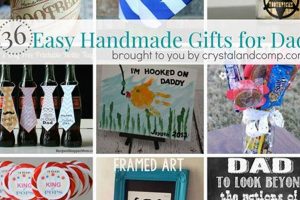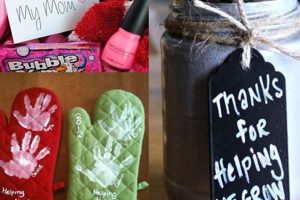Creating personalized drinkware during the holiday season involves modifying plain mugs with individual designs or messages suitable for gifting or personal use. These customized items allow for the application of diverse artistic techniques, ranging from simple painting to more complex methods like etching or heat transfer. For example, a plain white ceramic mug can be transformed with hand-painted holiday scenes or permanent marker designs sealed by baking in an oven.
Handcrafted presents offer a personal touch often absent in commercially produced goods. The practice of creating bespoke items fosters creativity and resourcefulness, providing an opportunity to tailor a gift specifically to the recipient’s tastes. Historically, handmade gifts have represented a tangible expression of care and effort, symbolizing a deeper connection between the giver and the receiver than mass-produced alternatives can convey. This act can also provide cost savings as opposed to buying ready made items.
The subsequent sections will explore a variety of techniques applicable to customizing drinkware, material considerations for achieving durable and visually appealing results, and practical safety guidelines for ensuring successful execution of these personalized projects.
Customizing Drinkware
Achieving professional-looking results requires attention to detail and adherence to established best practices. The following guidelines provide valuable insights for successfully personalizing drinkware for the holiday season.
Tip 1: Surface Preparation is Paramount: Thoroughly clean the mug surface with rubbing alcohol to remove oils or residue. This ensures optimal adhesion of paints, markers, or vinyl.
Tip 2: Select Appropriate Materials: Opt for paints specifically designed for ceramics or glass. Permanent markers labeled as “oil-based” offer superior durability compared to water-based alternatives.
Tip 3: Utilize Stencils for Precision: Stencils provide clean lines and consistent shapes, especially beneficial for intricate designs or lettering. Secure the stencil firmly to prevent paint bleeding.
Tip 4: Baking for Permanence: Many ceramic paints require heat-setting to achieve a durable finish. Follow the manufacturer’s instructions regarding temperature and baking time carefully. Improper baking can lead to cracking or peeling.
Tip 5: Layering for Depth: Applying multiple thin coats of paint, allowing each layer to dry completely, creates a richer, more vibrant color and enhances durability.
Tip 6: Consider Vinyl Decals for Intricate Designs: Die-cut vinyl decals offer a precise and professional appearance, particularly suitable for complex logos or patterns. Ensure proper adhesion using a squeegee.
Tip 7: Sealing for Protection: After baking or applying vinyl, consider using a food-safe sealant to protect the design from scratches and fading, especially if the item will be frequently washed.
Successful drinkware customization blends artistic vision with careful execution. By prioritizing surface preparation, material selection, and proper sealing techniques, durable and aesthetically pleasing results are achievable.
The subsequent section will delve into diverse design ideas suitable for holiday-themed drinkware, offering inspiration for creating unique and memorable gifts.
1. Material Selection
The selection of appropriate materials forms a foundational element in the success of creating personalized drinkware for the Christmas holiday. The type of mug chosen directly impacts the design’s adherence, the product’s longevity, and its overall suitability for intended use. Ceramic mugs, for example, offer a smooth, consistent surface amenable to various decorative techniques, including painting, stenciling, and heat transfer. However, variations in ceramic composition, such as the presence of glazes or textured finishes, can influence paint adhesion and image clarity. Porcelain, while possessing a refined aesthetic, may require specialized paints or adhesives due to its inherent smoothness and low porosity.
Furthermore, the choice of decorating materials, such as paints, markers, and sealants, must align with the mug’s intended use and the desired level of durability. Water-based paints, while readily available and easy to use, may lack the permanence required for items subjected to frequent washing. Conversely, oil-based paints or ceramic-specific formulations offer superior adhesion and resistance to wear, but may necessitate heat-setting to achieve optimal bonding. The application of sealants further enhances durability, providing a protective barrier against scratches, fading, and chemical damage from detergents. Neglecting to select materials compatible with both the mug substrate and the intended decorating technique often results in subpar aesthetics and diminished product lifespan.
In conclusion, discerning material selection is not merely a preliminary step but an integral determinant of the final product’s quality and suitability. Understanding the interplay between mug composition, decorating materials, and usage conditions allows for informed decisions that optimize both the aesthetic appeal and functional longevity of personalized drinkware created for Christmas gifting or personal enjoyment. Failure to prioritize this connection can undermine the time and effort invested in the decorative process, yielding unsatisfactory and impermanent results.
2. Design Complexity
Design complexity in personalized drinkware directly correlates with both the time investment and the required skill level. Elaborate designs, encompassing intricate patterns or detailed imagery, necessitate meticulous execution and often demand specialized tools or techniques. The selection of a design directly impacts the probability of a successful outcome, particularly for individuals with limited artistic experience. For example, a simple geometric pattern applied using stencils presents a significantly lower barrier to entry than a freehand rendering of a complex landscape. Furthermore, the complexity of the design influences the material choices. Intricate designs may necessitate the use of fine-tipped paintbrushes, specialized markers, or precision-cut vinyl decals to achieve the desired level of detail. The inability to manage design complexity effectively can result in a final product that deviates substantially from the intended aesthetic, potentially diminishing its perceived value as a personalized gift.
The practical application of this understanding involves a careful assessment of one’s artistic capabilities and available resources prior to commencing the decorating process. Scaling down design ambitions or opting for simpler, more manageable motifs can significantly increase the likelihood of achieving a satisfactory outcome, particularly when working with limited time or experience. Conversely, individuals possessing advanced artistic skills and access to specialized equipment, such as digital design software or vinyl cutting machines, can confidently undertake more intricate and ambitious projects. Real-world examples illustrate this point: A beginner might successfully create a charming holiday-themed mug using pre-cut vinyl snowflakes, while an experienced artist could hand-paint a detailed depiction of a winter scene. These outcomes are directly connected to the level of design complexity undertaken and the individual’s ability to execute it effectively.
In summary, the deliberate consideration of design complexity constitutes a critical element in the successful creation of personalized drinkware. The challenge lies in aligning the design’s ambition with the individual’s skill set and available resources. A realistic assessment of these factors enables the selection of a design that is both visually appealing and practically achievable, maximizing the probability of producing a cherished and well-executed holiday gift. Overestimating one’s capabilities or underestimating the time required can lead to frustration and a subpar finished product, underscoring the importance of careful planning and design selection.
3. Technique Proficiency
Technique proficiency represents a critical determinant in the successful execution of personalized drinkware projects during the Christmas season. The level of skill applied directly influences the aesthetic quality, durability, and overall perceived value of the finished product. Mastery of specific techniques is paramount to achieving desired results and minimizing potential errors.
- Paint Application Mastery
Paint application involves precise brush control, appropriate paint consistency, and an understanding of layering techniques. For instance, uneven paint application can result in streaks, bubbles, or an unprofessional finish. Proficiency allows for smooth, consistent coverage and the creation of nuanced effects, such as shading and highlighting, enhancing the visual appeal of the holiday-themed design. Conversely, a lack of skill may necessitate multiple attempts, increasing the risk of errors and material waste.
- Stenciling Precision
Stenciling requires accurate placement, secure adhesion to prevent paint bleed, and controlled application of paint or other media. Poor stenciling technique leads to blurred lines, distorted shapes, and a reduction in the overall clarity of the design. A skilled individual can utilize stencils to create crisp, clean images, lettering, or patterns that contribute to a polished and professional appearance. Proper handling of stencils also ensures longevity and reusability, increasing efficiency for multiple projects.
- Heat Setting Expertise
Heat setting, often required for ceramic paints, demands precise temperature control and adherence to manufacturer instructions. Improper heat setting results in inadequate paint bonding, leading to chipping, cracking, or peeling during use. Proficiency in this area ensures that the design becomes permanently fused to the mug surface, maximizing its durability and resistance to wear. Accurate temperature regulation also prevents damage to the mug itself, such as cracking or shattering during the baking process.
- Vinyl Application Acuity
Vinyl application necessitates precise cutting, weeding, and transfer techniques to ensure clean lines and secure adhesion. Inadequate vinyl application results in bubbles, wrinkles, or lifting edges, compromising the design’s aesthetic appeal and longevity. A skilled individual can seamlessly apply vinyl decals, creating intricate and professional-looking designs that withstand repeated washing and handling. Furthermore, proficiency minimizes the risk of tearing or damaging the vinyl during the application process, reducing material waste and rework.
The successful creation of individualized drinkware for Christmas requires a deliberate cultivation of technique proficiency. The level of skill directly impacts the aesthetic outcome, product durability, and the overall impression of a carefully crafted gift. The skills acquired in this process offer benefits that extend beyond this specific domain, fostering a general sense of accomplishment and encouraging continued engagement with creative pursuits.
4. Heat Setting
Heat setting represents a crucial process in the creation of customized drinkware, particularly when utilizing ceramic paints or certain types of permanent markers. Applied to DIY mugs intended as Christmas gifts, heat setting ensures the durability and longevity of the applied designs. The process involves subjecting the decorated mug to a specific temperature for a predetermined duration within a conventional oven or specialized heat press. The heat facilitates a chemical reaction within the paint or marker, causing it to bond permanently to the ceramic surface. Without proper heat setting, the applied designs are susceptible to chipping, scratching, or fading during regular use and washing, diminishing the overall value and appeal of the personalized gift.
The effectiveness of heat setting is directly linked to adherence to manufacturer instructions regarding temperature and duration. Deviations from these guidelines can yield undesirable outcomes. Under-baking results in insufficient bonding, leaving the design vulnerable to damage. Conversely, over-baking can cause discoloration, cracking of the ceramic, or even the release of potentially harmful fumes from certain paint formulations. Successful heat setting is often confirmed through visual inspection; properly baked designs exhibit a smooth, glossy finish and resist scratching with moderate pressure. Practical examples include mugs decorated with intricate holiday-themed patterns using ceramic paint, which remain vibrant and intact after repeated dishwasher cycles, thanks to accurate heat-setting procedures.
In summary, heat setting is an indispensable step in creating durable and visually appealing customized drinkware for Christmas. Proper execution, guided by manufacturer specifications, ensures that the personalized designs withstand the rigors of daily use, preserving the sentimental value and aesthetic appeal of the gift. Overlooking this crucial process undermines the time and effort invested in the decorating process, resulting in a product that is ultimately fragile and disappointing. Therefore, a thorough understanding of heat-setting principles and their application to specific materials represents a fundamental requirement for successful DIY mug projects intended for the holiday season.
5. Food Safety
Food safety considerations are paramount when creating personalized drinkware for Christmas, particularly items intended for consumption of beverages. The materials used in decorating mugs must be non-toxic and inert, preventing the leaching of harmful chemicals into the drink. Failure to prioritize food safety introduces the risk of acute or chronic health problems for the user. For instance, certain paints or adhesives contain lead or cadmium, substances known to be toxic if ingested even in small quantities. Therefore, any material directly contacting the beverage must be certified as food-safe and designed for use on surfaces intended for food contact. A real-life example involves poorly manufactured mugs decorated with unapproved glazes, resulting in lead contamination and subsequent product recalls.
The selection of appropriate decorating techniques also directly impacts food safety. Techniques that involve scratching or etching the surface of the mug may create microscopic crevices that harbor bacteria, even after washing. Similarly, improper application of vinyl decals can lead to the formation of air pockets where mold or bacteria can proliferate. To mitigate these risks, sealing the decorated surface with a food-safe sealant is recommended. However, the sealant itself must also be carefully chosen to ensure its compatibility with both the decorating material and the mug substrate. Practical application includes selecting sealants specifically designed for ceramic surfaces that have undergone heat-setting processes to ensure adequate bonding and resistance to leaching.
In conclusion, food safety is not merely a supplementary concern but an intrinsic component of crafting personalized drinkware. Overlooking this facet compromises the recipients health and safety. A thorough understanding of material properties, decorating techniques, and sealant compatibility is essential. While personalized mugs offer a unique and thoughtful gift, this inherent sentiment is rendered meaningless if it causes health issues. Diligence in adhering to food safety standards is indispensable for ethical and responsible creation.
6. Durability
Durability, in the context of DIY mugs for Christmas, signifies the capacity of a decorated mug to withstand regular use, washing, and temperature fluctuations without degradation of its aesthetic or structural integrity. The long-term viability of personalized drinkware as a cherished gift hinges on its ability to maintain its original condition despite repeated use.
- Material Resistance to Abrasion
The inherent resistance of the chosen mug substrate and decorative materials to abrasion from washing, handling, and utensil contact is a critical facet. Ceramic mugs with low-quality glazes or decorations applied with non-durable paints are prone to scratching, fading, and chipping. For instance, a mug decorated with acrylic paint not designed for ceramic surfaces will likely exhibit significant wear within a few wash cycles, rendering the gift less appealing. Choosing durable materials is essential for ensuring longevity.
- Adhesion Strength of Decorative Elements
The strength with which decorative elements, such as paint, vinyl decals, or applied embellishments, adhere to the mug’s surface directly impacts its lifespan. Poor adhesion leads to peeling, lifting, or detachment of the decoration, compromising its visual appeal and potentially creating a safety hazard if ingested. Real-world examples include vinyl decals applied without proper surface preparation or inadequate heat-setting, resulting in premature peeling and detachment from the mug’s surface.
- Resistance to Thermal Shock
The ability of the mug to withstand rapid temperature changes without cracking or shattering is a crucial aspect of durability, particularly if the mug is intended for use with hot beverages. Mugs made from low-quality ceramic or those with existing structural flaws are susceptible to thermal shock when exposed to boiling water or sudden cooling. An example of this is a mug cracking when transitioning from a cold environment to being filled with hot coffee, resulting in immediate breakage and rendering the gift useless.
- Chemical Stability of Decorative Materials
The resistance of the decorative materials to degradation from exposure to common household chemicals, such as detergents, dish soap, and acidic beverages, is a significant consideration. Certain paints or sealants may react adversely to these chemicals, leading to discoloration, fading, or erosion of the decorated surface. For example, mugs decorated with paints that are not dishwasher-safe may experience significant fading or peeling after repeated washes with strong detergents.
These facets of durability are interconnected and collectively determine the longevity and usability of DIY mugs intended as Christmas gifts. Selecting high-quality materials, employing appropriate decorating techniques, and ensuring proper sealing are essential for maximizing the mug’s resistance to wear, damage, and chemical degradation. Ultimately, a durable DIY mug not only provides a lasting memento of the holiday season but also reflects the thoughtfulness and care invested in its creation.
7. Presentation
Presentation, in the context of handcrafted mugs for the Christmas holiday, extends beyond mere aesthetics; it is an integral component that elevates the perceived value and emotional impact of the gift. A thoughtfully decorated mug, while intrinsically valuable as a personal creation, is amplified through deliberate presentation. A chipped, smeared, or otherwise poorly presented item undermines the effort invested in its creation, potentially diminishing the recipient’s appreciation. Conversely, meticulous packaging and an intentional presentation strategy communicate care and consideration, augmenting the perceived quality of the handmade gift. For example, a meticulously painted mug, wrapped in simple brown paper with a sprig of evergreen and a handwritten tag, conveys a message of personalized attention that surpasses that of an identically decorated mug simply handed over without adornment. The absence of thoughtful presentation renders the product incomplete, reducing its intended impact.
Practical considerations for enhancing presentation encompass several key areas. The selection of appropriate packaging materials is crucial; a sturdy box or gift bag provides physical protection and contributes to the visual appeal. Using materials that complement the mug’s design, such as tissue paper in coordinating colors or ribbons with a holiday theme, adds a layer of sophistication. Furthermore, the inclusion of a personalized card or tag allows for the expression of heartfelt sentiments, further enhancing the emotional connection between the giver and the recipient. Consider the effect of including a small packet of gourmet hot chocolate or coffee with the mug, creating a cohesive gift package that extends the experience beyond the visual. The practical application of these strategies demonstrates an understanding of the psychological impact of presentation on gift-giving and the recognition that the perceived value of a handcrafted item is inextricably linked to its appearance upon receipt.
Ultimately, presentation serves as the final touchpoint in the creation of a personalized mug for Christmas, transforming a simple handmade item into a cherished and memorable gift. Neglecting this aspect represents a missed opportunity to maximize the impact of the gift and communicate the depth of care invested in its creation. While challenges in presentation may arise from budgetary constraints or limitations in access to resources, even simple and cost-effective strategies can significantly enhance the perceived value and emotional resonance of the handmade gift. By prioritizing deliberate presentation, the giver reinforces the message that the gift is more than just a material object but a tangible expression of affection and thoughtfulness. This links back to the broader theme of handcrafted gifts as vehicles for meaningful connection and personal expression during the holiday season.
Frequently Asked Questions
The following addresses common inquiries regarding the creation of personalized drinkware, offering guidance on materials, techniques, and safety considerations.
Question 1: What types of mugs are best suited for customization?
Ceramic and porcelain mugs are generally recommended due to their smooth surfaces and heat resistance. However, the chosen material should be free of cracks or imperfections that may compromise its structural integrity during the decorating or heat-setting process.
Question 2: What paints are safe for use on drinkware intended for beverage consumption?
Only paints specifically labeled as food-safe and designed for ceramic or glass surfaces should be utilized. These paints typically require heat-setting to ensure durability and prevent leaching of harmful chemicals into the beverage.
Question 3: How can one ensure the longevity of the decorated design on a mug?
Proper surface preparation, the application of durable paints, and adequate heat-setting are crucial. Sealing the finished design with a food-safe sealant can further enhance its resistance to scratching and fading.
Question 4: What safety precautions should be observed during the heat-setting process?
Heat-setting should be performed in a well-ventilated area, adhering strictly to the paint manufacturer’s instructions regarding temperature and baking time. Avoid overcrowding the oven and monitor the mugs closely to prevent overheating or cracking.
Question 5: Can vinyl decals be used to decorate mugs, and if so, what considerations apply?
Yes, vinyl decals designed for permanent adhesion can be used. Ensure that the surface is clean and smooth before application. While vinyl is generally considered food-safe on exterior surfaces, avoid placing decals on areas that come into direct contact with the beverage.
Question 6: What steps should be taken to clean and maintain customized mugs?
Hand washing with mild soap is generally recommended to preserve the integrity of the decorated design. Avoid abrasive cleaners or scouring pads, as these can scratch or damage the surface. While some mugs may be dishwasher-safe, refer to the paint or sealant manufacturer’s instructions for specific guidelines.
Successful creation of personalized drinkware requires careful attention to materials, techniques, and safety. Adherence to established best practices ensures aesthetically pleasing and long-lasting results.
The following explores further refinements to elevate the design and personalization process.
Conclusion
The preceding discourse has explored the multifaceted aspects of DIY mugs for Christmas, encompassing material selection, design considerations, technical proficiency, and essential safety protocols. This involved in-depth analyses of the importance of each step, material, designs, and the potential risks involved to produce best result. The process involves a blend of creativity, technical skill, and adherence to safety to produce items of value.
The crafting of personalized drinkware during the festive season represents a tangible expression of thoughtfulness and care. It necessitates careful attention to detail and a commitment to quality. As individuals engage in this creative endeavor, a meticulous approach will result in meaningful and lasting tokens of goodwill and unique personalised gifts for their loved ones. The future will likely see the implementation of technology to the process, further refining the efficiency of creating these gifts.







